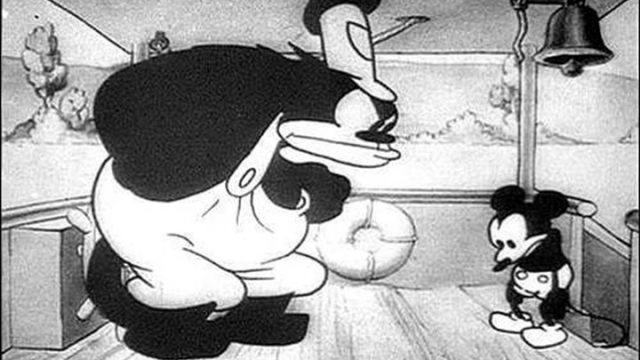As we’ve already discussed, “Steamboat Willie” was not the first Mickey Mouse cartoon but the third. It’s known as the first because it is the first to get a distribution deal. It isn’t the first cartoon with synchronized sound, either, but it’s the first successful one with fully synchronized sound. It is, let’s be real, the start of the Mouse as empire—though, as we’ll discuss, its copyright status is not as certain as Disney would like you to believe.
There’s not a lot of plot, here. Mickey is piloting a steamboat. It turns out the actual captain is Pete. Mickey is kicked off the bridge. They pick up animals at “Podunk Landing.” Minnie misses the boat, and Mickey picks her up. Together, they use various animals to play “Turkey in the Straw” after a goat eats the sheet music. Captain Pete makes Mickey peel potatoes.
Of course, none of these characters get names. There’s barely any real dialogue to the piece, just the music and sound effects. I’m honestly not sure when the characters first got names in their cartoons. The relationships among the trio are quite clear already; there is no introduction here. They all know each other, even if we do not know them. Cartoon characters do not seem to need origin stories.
Now, I am not a lawyer. And Disney has threatened to sue a law student who wrote a paper about it, claiming “slander of title.” (In short, issuing a claim that muddies title statements.) But apparently, the cartoon included a few violations of the Copyright Act of 1909 and should therefore be in the public domain. Disney, of course, disputes this and indeed has lobbied Congress on multiple occasions to extend the copyright; it’s currently held by the Disney corporation for another five years, and we’ll see how things change from there.
It is hard, sometimes, being a fan of Disney for reasons like that. Let’s face it; Disney is not always a beneficent force in the world. I’m broadly in support of copyright as a concept—as you all know, it would be nice if I made money from these articles, and that barely happens now, much less if someone else could use my work for their own purposes without payment or attribution. But there’s no reason for my heirs to still hold a lock on it fifty years after I die—heirs that like as not had never even met me.
The cartoon has been adapted, parodied, and borrowed from since 1928. There is, of course, “Steamboat Itchy,” from The Simpsons. And these days, Disney films open with the image of Mickey whistling on the bridge of the boat. And yet for something so world-changing, it comes across as slight. There’s no real story. A few sight gags, but not much in the way of jokes. Basically no dialogue. Mickey does stuff. The end. Yet here it is, ninety years later, and I felt as though Year of the Month would miss something if we didn’t include at least a little discussion of it.
Oh, and the title? Yeah, I didn’t know this until quite recently. There was a Buster Keaton film named Steamboat Bill, Jr, itself a play on a song called “Steamboat Bill.” Which is the song Mickey’s whistling at the beginning. These cultural references have been left behind, but there are Mickey and Minnie and Pete, still going.
Help me keep going; consider supporting my Patreon!

